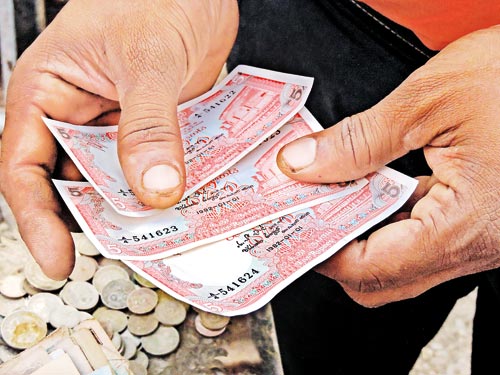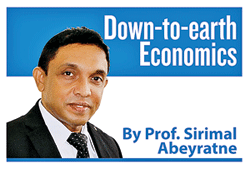Global economy: Heating up vs. cooling down
View(s):
Money printing: These are Rs. 5 currency notes no longer in circulation.
The movements in the global economy during the post-COVID time are interesting. In the US, EU and the UK, it was unusually high inflation. Japan, that failed to produce at least 2 per cent inflation rate for many years, began to see it rising to over 4 per cent. Even many of the Western European countries, including Scandinavian region, which experienced rising inflation had ‘deflationary’ fear during the COVID time.
China, the second largest economy in the world, is an outlier. In fact, China has always been an “outlier” in different ways, but this time it has deflation; its rate of inflation remained around zero per cent after April 2023, also with negative rates reported in some of the months.
With all that, the economic chaos in the world has taken a new turn during the post-COVID time. It has also contributed by the soaring energy costs, international conflicts and power struggles. There is mounting uncertainty out of which some may lose, while some others could even benefit.
Let us, however, focus on inflationary and deflationary tendencies alone, together with policy responses in the respective countries.
Lockdown in COVID times
The world economy plunged to a lockdown mode during the COVID time, but almost everywhere there were fiscal and monetary stimulus packages. Economists know that the world becomes Keynesian in crisis times! This means that at the time when private spending becomes weaker, the government spending becomes stronger.
But the irony is that at the time that the government spending must be stronger, it doesn’t have money because tax revenue from private incomes and spending declines. Here comes the Keynesian remedy for that; borrowings and money printing! Thus, government spending to support business and households was naturally accompanied by increased money stock and debt pile.
The conventional theory that ‘money growth leads to inflation’ doesn’t seem to be valid anymore, as was during the COVID time. World inflation appears to be down even with deflationary tendencies in some places in the face of growing money and credit. Perhaps, we might go too far to conclude that the money growth can make us prosperous too!
But we must not jump to any conclusion as such by forgetting some of the underlying economic realities. In the first place, there was more room for monetary expansion during COVID time due to subdued demand conditions: That is the demand for output supplies originating from consumers, businesses and foreign markets. In the second place, money may lead to inflation not overnight, but only after a time lag.
Bitter policy dose
Having observed the lockdown world economy and the successful global vaccine programme, we wrote in this column on 12 September 2021 about what we must anticipate next: “Bitter policy dose after vaccines”. That is about the possibility of reversing the loose monetary policy along with containing the budget deficits, to deal with rising inflation! This was to be done with raising policy rates, while slashing bond purchases and halting quantitative easing practices.
 As the lockdown was lifted and the economies were freed from the clutches, aggregate demand rose abruptly. As the restoration of production and supply chains was not as fast as the increase in aggregate demand, the outcome was the rise of inflation due to the advent of excessive demand conditions.
As the lockdown was lifted and the economies were freed from the clutches, aggregate demand rose abruptly. As the restoration of production and supply chains was not as fast as the increase in aggregate demand, the outcome was the rise of inflation due to the advent of excessive demand conditions.
In mid-2022, the inflation rate skyrocketed to over 9 per cent in the US, over 10 per cent in the UK and Euro Area. Among other things, the typical central banking response to inflationary pressure is the use of policy rates. The US Federal Reserve Bank (Fed) which maintained its average Fund Rate at 0.25 per cent until early 2022, started raising it gradually till reaching 5.5 per cent by December 2023.
The European Central Bank (ECB) too which maintained the standing deposit facility rate at zero level until the mid-2022, kept on raising it gradually to 4.5 per cent by December 2023. The Bank of England also followed by raising its benchmark interest rate during the past two years from 0.25 per cent to 5.25 per cent by December 2023.
For Japan, breaking away from the deflationary impasse was a welcome development. Accordingly, the Bank of Japan kept its key short-term interest rate unchanged at -0.1 per cent as was during the COVID time, and its long-term interest rate for 10-year bond at around zero per cent.
China, the outlier
While the West was experiencing inflationary tendencies and calling for tight monetary policy measures, China was moving in the opposite direction. As the country is caught up in a deflationary tendency, as expected the People’s Bank of China must keep its policy rates on a downward path even during the post-COVID time.
Yet the success of this conventional monetary policy measure is yet to be seen in the coming months of the New Year. It didn’t see much success in Japan for decades, when Japan was caught up in deflation.
In a nutshell, over-supply and weak-demand in China – a rather unanticipated economic outcome during the post-COVID time – has resulted in a deflationary pressure. From a macroeconomic point of view, deflation is not an adorable economic outcome. A continuous fall in average prices of goods and services is a sign of a weakening economy.
In a deflationary situation as such, private spending too tends to decline. When the consumers and businesses experience falling prices and anticipate that future prices would be falling further, they tend to postpone their spending decisions. Accordingly, aggregate demand falls, and, in response, the economy is likely to contract.
Sri Lanka and Bangladesh
Tight monetary policy and credit control through higher interest rates are intended to suppress aggregate demand in an inflationary situation. These movements are pushed in reverse direction when there is deflation: Increased money supply and credit expansion through lower interest rates are intended to stimulate aggregate demand.
The policies may or may not work bringing about an intended policy outcome. An interesting comparison and contrast could be seen between Sri Lanka and Bangladesh. Both countries adopted fiscal and monetary policy stimulus during the COVID time as elsewhere in the developing world. Both countries were also caught up in inflation during the post-COVID time.
Sri Lanka experienced hyper-inflation running at nearly 50 per cent as its average annual rate in 2022. The Central Bank tightened monetary policy measures including the increase in its standing deposit facility rate from below 6 per cent to over 14 per cent in April 2022. Besides, the economic crisis during the post-COVID time resulting in a loss of incomes and jobs appear to have effectively cut down the purchasing capacity of the consumers and the businesses. Inflation was contained due to both the policy effect and the crisis impact.
Bangladesh experienced a rising inflation reaching 10 per cent in the past few months since April 2023. The Central Bank of Bangladesh too started raising its benchmark policy rate gradually from 4.75 per cent in April 2023 to 6.50 per cent in November 2023. But inflation doesn’t seem to have responded to the Central Bank’s tight monetary policy measures.
Transmission channel
Once the decision to change the policy rates are taken at the top-level, its intended effects should be transmitted effectively to the grassroot level touching the spending decisions of every individual entity as consumers and businesses. If the transmission channel is weaker vis a vis the link between interest rates and aggregate demand, then the intended impact of policy decisions over aggregate demand and inflationary pressure is also marginal.
Besides, Sri Lanka had an economic crisis impact which had cut down the spending ability of the public ruthlessly, whereas in Bangladesh there was no economic crisis as such.
In advanced countries such as the US, the EU and the UK, the policy transmission mechanism is stronger so that the monetary policy changes have a significant impact over the control of the heating up of the economy. In contrast, it is still too early to see if the reverse monetary policy measures can halt the cooling down of the Chinese economy.
(The writer is a former Professor of Economics at the University of Colombo and can be reached at sirimal@econ.cmb.ac.lk and follow on Twitter @SirimalAshoka).
Hitad.lk has you covered with quality used or brand new cars for sale that are budget friendly yet reliable! Now is the time to sell your old ride for something more attractive to today's modern automotive market demands. Browse through our selection of affordable options now on Hitad.lk before deciding on what will work best for you!


